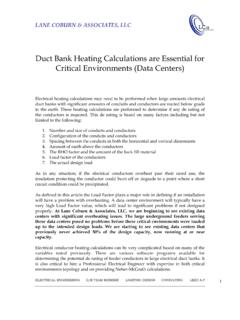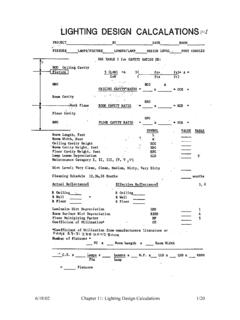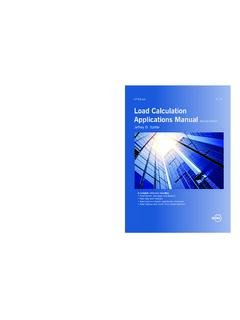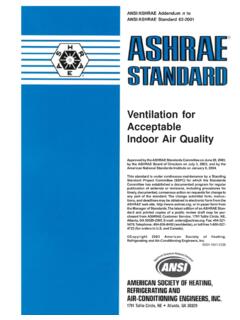Transcription of Heat Loss Calculations and Principles - CED Engineering
1 Heat Loss Calculations and Principles Course No: M05-003 Credit: 5 PDH A. Bhatia Continuing Education and Development, Stonewall CourtWoodcliff Lake, NJ 07677P: (877) heating LOSS Calculations & Principles Introduction There are two different but related calculated values of interest to the heating system designer. The first is to estimate the maximum rate of heat loss to properly size the heating equipment (furnace). The second calculated value that must be determined is the annual heating bill. This is determined by calculating the annual energy requirement based from the design heat loss rate. In this course, we will learn to determine the rate at which heat is lost through building elements using a process called heat loss calculation . You will learn how to extrapolate your calculation of a maximum hourly rate into an annual energy usage rate.
2 You will also learn some useful tips on saving heating energy. The section-3 of the course includes one sample example. Factors Affecting Comfort in winter 1. TEMPERATURE difference between the inside and outside of the building is the primary cause of heat loss in the winter months. The greater this difference, the higher the rate of heat loss. Since most buildings are controlled to a constant inside temperature by the occupants, higher heat loss occurs when it is colder outside. This also means that the annual heating bill can be reduced by lowering the setting on the thermostat .. (but only if the occupants agree to it!) 2. WIND is the second greatest source of heat loss during the winter. High winds can occur on the cold nights and when they do, heat loss can be higher because of air scrubbing the outside of the space covering. Winds can also force their way through cracks in the structure, causing infiltration and drafts.
3 In fact, up to one-third of the annual heating energy goes to heat this moving infiltration air many times each winter day. 3. HUMIDITY levels can also affect the comfort within a structure. Very low humidity levels (less than 20% relative humidity) cause scratchy throats and dry noses in most people. Very high humidity levels (over 60%) are also uncomfortable, since the body's ability to perspire is restricted. 4. RADIATION sources can also affect comfort in a structure. The sun shining through a window will make a room very comfortable in winter; that same sun could make it unbearable in summer. Walls and windows also release and absorb radiation. A Trombe wall heated by the sun will keep a room feeling warm with an air temperature less than 60 F. A large expanse of cold glass windows can also make a room feel chilly. Remember that these same four factors are also important in determining cooling requirements, but control of humidity and solar gain are much more important during that season.
4 heating LOSS ESTIMATION The heat loss is divided into two groups: 1) The conductive heat losses through the building walls, floor, ceiling, glass, or other surfaces, and 2) The convective infiltration losses through cracks and openings, or heat required to warm outdoor air used for ventilation. Normally, the heating load is estimated for winter design temperature usually occurring at night; therefore, in determining the heating load, credit for heat generation from internal heat sources such as lights, machinery, appliances, and people is usually ignored. Also in determining the heating load, credit for solar heat gain is usually NOT included and is generally ignored. Credit for solar heat gain is a plus factor in winter heating . HEAT LOSS FROM BUILDING ENVELOPE (Wall, Roof, Glass) Heat loss occurs from a building structure primarily due to conduction. Because heat moves in all directions, when calculating the heat loss of a building, we much consider all surfaces (external walls, roof, ceiling, floor, and glass) that divide the inside, heated space from the outside.
5 We refer to that dividing line as the Building Envelope. The heat loss is determined by equation: Q = A * U * (Ti To) Where o Q = Total hourly rate of heat loss through walls, roof, glass, etc in Btu/hr o U = Overall heat-transfer coefficient of walls, roof, ceiling, floor, or glass in Btu/hr ft2 F o A = Net area of walls, roof, ceiling, floor, or glass in ft2 o Ti = Inside design temperature in F o To = Outside design temperature in F Let's examine each one of these terms, starting at the bottom with the outside design temperature. Outside Design Temperature (To) Look up for location Since the inside of the building is controlled to a fixed temperature by the thermostat, the maximum rate of heat loss will occur during the record cold temperature. When designing the heating system for a structure, the first step is to obtain data on the local micro climate of the region.
6 This information is available from a variety of sources, but HVAC designers normally use the ASHRAE Fundamentals Handbook for ready reference. As a basis for design, the most unfavorable but economical combination of temperature and wind speed is chosen. The winter month heating load conditions are based on annual percentiles of and 99%, which suggests that the outdoor temperature is equal to or lower than design data and 1% of the time respectively. For example, the Pittsburgh, PA, 99% design temperature is 4 F. Only one percent of the hours in a typical heating season (about 35 hour s total) fall at or below that temperature. Since most of these hours are during the night-time when most people are sleeping, and because these extremes are buffered by the large storage mass of the building, these cooler periods usually go unnoticed. Inside Design Temperature (Ti) Always use 65 F The inside design temperature is traditionally taken as 65 F, because in most buildings there is enough heat internally generated from people, lighting, and appliances.
7 Today people are keeping thermostats set lower, so load predictions based on this method are usually conservative, and will result in furnace size recommendations that are slightly larger than actually needed. Note that the temperature difference between the inside and outside of the building is the primary cause of heat loss in the winter months. The greater this difference, the higher the rate of heat loss. Since most buildings are controlled to a constant inside temperature by the occupants, higher heat loss occurs when it is colder outside. Net Area (A) Measured on the drawing/building The net area of each building section is determined from either the drawings (in new construction) or from field measurements (in retrofit situations). In addition to the areas of the four walls, floor, and ceiling, we must also consider heat loss from doors and windows. We will also need to determine the volume of the building to estimate the rate of infiltration into the building measured in air changes per hour.
8 Overall Coefficient of Heat Transfer (U) Look up for materials used The letter "U" represents the overall coefficient of heat transfer. The U-value measures how well a building component, a wall, roof or a window, keeps heat inside a building. For those living in a warm climate the U-value is also relevant as it is an indicator of how easy it is to keep the inside of the building cold. The higher the U-value the more heat flows through so a good U-value is a low one as you want to keep heat inside the building or outside depending on the climate you live in. A house built with low U-value building components will use less energy and thus the building owner saves money on the energy bill. Using less energy is good for the environment. U factor is the inverse of R factor, ( U = 1 / R ); the larger the R-value or the lower the U factor, the lower the heat loss.
9 Calculating the U-value is often complicated by the fact that the total resistance to the flow of heat through a wall made of several layers is the sum of the resistances of the individual layers. This aspect is discussed in detail in subsequent sections. Heat Loss (Q) Total hourly rate of heat loss through walls, roof, glass is given by equation Q = U * A * T. For example: 10 sq-ft. of single glass [U value of ] with an inside temperature of 70 F and an outside temperature of 0 Fwould have 791 BTUH heat loss: A (10) x U ( ) x T (70) = 791 Btu/hr Since the building structure is made of different materials, for example a wall that contains windows and door, just calculate the heat loss through each of the components separately, then add their heat losses together to get the total amount. Q (wall) =Q (framed area) +Q (windows) +Q (door) In North America, heat loss is typically expressed in terms of total British Thermal Units per Hour or Btu/hr.
10 HEAT LOSS FROM FLOORS ON SLAB Heat loss from floors on slab can be estimated by equation: Q = F * P * (Ti - To)Where: 1) F is the Heat Loss Coefficient for the particular construction in Btu/hr- ft- F 2) P is the perimeter of slab in ft 3) Ti is the inside temperature in F 4) To is the outside temperature in F Heat loss from slab-on- grade foundations is a function of the slab perimeter rather than the floor area. Perimeter is the part of the foundation or slab nearest to the surface of the ground outside. The losses are from the edges of the slab and insulation on these edges will significantly reduce the heat losses. For basement walls, the paths of the heat flow below the grade line are approximately concentric circular patterns centered at the intersection of the grade line and the basement wall. The thermal resistance of the soil and the wall depends on the path length through the soil and the construction of the basement wall.

















